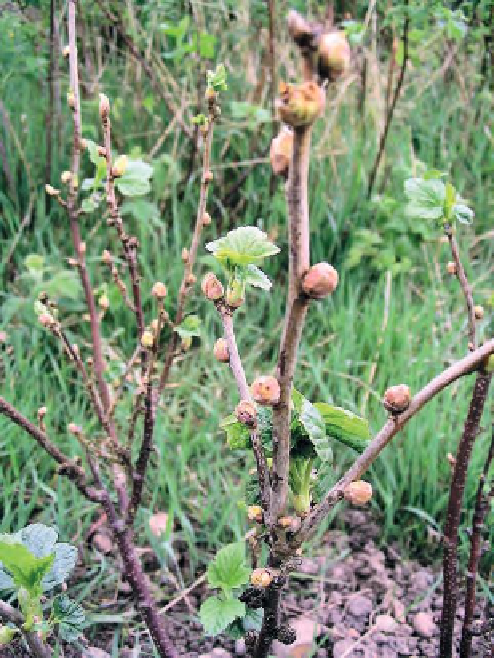Agriculture Reference
In-Depth Information
Other arthropod pests
In addition to insects and mites, the phylum
Arthropoda contains three other horticulturally
relevant groups, the
Crustacea
(woodlice),
Symphyla
(symphilids) and
Diplopoda
(millipedes), which can
cause damage to plants (see also Table 18.1).
Woodlouse (
Armadillidium nasutum
)
damage
is confined mainly to greenhouse plants where
stems and lower leaves of succulent plants
such as cucumbers, but occasionally young
outdoor transplants, may be nipped. This species
(Figure 18.27a) has adapted to terrestrial life, but still
requires damp conditions to survive.
Soil-placed glue
traps
used for a range of soil pests
are effective in
control.
Symphilids (
Scutigerella immaculata
)
resembling
tiny white millipedes eat root hairs and may cause
lettuce to mature without a heart, and also allow
Botrytis
infections. Their presence may be detected by
placing suspect soil into a bucket of water to identify
the pest floating on the water surface.
Millipedes
are
slow-moving creatures with many legs
(two pairs to each body segment). Several species
are useful in breaking down soil organic matter, but
two pest species, the flat millipede (
Brachydesmus
superus
) and a tropical species (
Oxidus gracilus
),
can cause damage to roots of strawberries and
cucumbers, respectively.
Centipedes
superficially
resemble millipedes, but are
much more active. They help to control soil pests by
searching for insects, mites and nematodes in the soil
(Figure 18.27b).
Figure 18.26
Blackcurrant gall mite. Note the swollen
spherical buds
on
Fuchsia
,
Pelargonium
and
Cyclamen
. Care should
be taken to prevent introduction of infested plants
and propagation material into glasshouses. No reliable
control is available for the gardener.
Other mites
Three other horticulturally important mites require a
mention. The
fruit tree red spider mite
(
Panonychus
ulmi
) can cause serious leaf mottling of ornamental
Malus
and apple. The
conifer spinning mite
(
Oligonychus ununguis
) causes spruce leaves to
yellow, and the mite spins a web of silk threads.
Bryobia mite
(e.g.
Bryobia rubrioculus
) is found on a
wide range of trees. It may attack fruit trees, and more
seriously cause damage to greenhouse crops such
as cucumbers, if blown in from neighbouring trees.
The two-spotted mite predator,
Phytoseiulus
, is not
effective against bryobia mite.
Also, recently, there have been two newly reported
mite problems in Britain and Ireland. Hazel shrubs
are being attacked by
hazel big bud mite
(
Phytopus
avellanae
).
Fuchsia gall mite
(
Aculops fuchsiae
) is
causing young
Fuchsia
leaves to become red and
distorted.
Nematode pests
This group of organisms, also called
eelworms
, is
found in almost every part of the living world. They
range in size from the large animal parasites, such as
Ascaris
(about 20 cm long) in the guts of livestock to
the tiny soil-inhabiting species (about 0.5 mm long).
Non-parasitic species in soil are often beneficial,
feeding on plant remains and soil bacteria, and
helping in the formation of
humus
(see p. 158). The
general structure of the nematode body is shown in
Figure 18.29. A feature of the plant parasitic species
is the
spear
in the mouth region, which is thrust into
plant cells. Salivary enzymes are then injected into the
plant and the plant juices sucked in by the nematode.
Nematodes are very active animals, moving in a
wriggling fashion in soil moisture films, most actively
when the soil is at
field capacity
and more slowly
as the soil either waterlogs or dries out.
Symptoms

